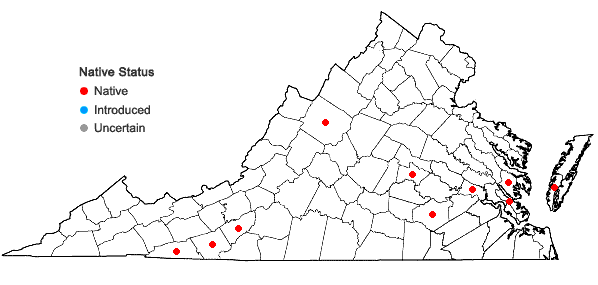Senega aquilonia (Fern. & Schub.) J.F.B. Pastore & J.R. Abbott
No images available.

Detail
- Family
- Polygalaceae
- Botanical Name
- Senega aquilonia (Fern. & Schub.) J.F.B. Pastore & J.R. Abbott
- Common Name
- Northern Cross-leaved Milkwort
- Synonym(s)
- Polygala aquilonia (Fern. & Schub.) Sorrie & Weakley; Polygala cruciata L. var. aquilonia Fern. & Schubert
- Flora of Virginia Name/Status
- Polygala cruciata L. var. aquilonia Fern. & Schubert
- Comments
- Recent studies by Pastore et al. (2019, Taxon 68: 673-691) demonstrated that the New World members and Old World members of the large and non-monophyletic genus Polygala (sensu lato) are phylogenetically, morphologically, and geographically separated into two clades and cannot be considered congeneric. Since the type species of the genus is in the Old World group, the New World species (including all from Virginia) were re-assigned to the genus Senega Spach 1838 (Pastore et al., 2023, Ann. Mo. Bot. Gard. 108: 126-249).
Senega aquilonia is northern, ranging south, primarily inland, to ne. AL while the similar Senega cruciata occurs primarily on the southeastern Coastal Plain with a few inland disjunctions. The two species are sympatric in eastern Virginia, and can be difficult to distinguish there due to specimens of intermediate or equivocal morphology. Sorrie and Weakley (Phytologia 2017-37: 1-9) conducted a morphological / ecological study of this complex, concluding that the two taxa (under Polygala) represent distinct evolutionary lineages and merit recognition at the species level, a conclusion evidently followed by Pastore et al. (2023, Ann. Mo. Bot. Gard. 108: 126-249) in the transfer to Senega. Senega aquilonia has a disjunct distribution in Virginia represented by the few montane occurrences of the species and a small subset of populations in eastern Virginia. The distribution is based primarily on annotations made by Bruce Sorrie (NCU) in 2016.
- Habitat
- Fens (calcareous and mafic) in the mountains; open, sphagnous wetlands and wet sands elsewhere; habitats similar to the nominate variety. Infrequent to rare in the Coastal Plain and outer Piedmont of c. and se. Virginia; rare in the mountains (Ridge and Valley province and Southern Blue Ridge).
- Native Status
- Native
To save this map, right-click (control-click for Mac users) on the map and choose "Save Image As...".